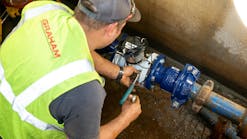Nanofiltration (NF) was developed in the 1980s, which was significantly later than other membrane technologies, and NF still addresses a significantly smaller market than reverse osmosis (RO). The NF market has a value of about $250-300 million, which is about 15 percent of the size of the RO market. The market is diverse, with multiple specialised applications addressed by differentiated offerings from a range of product types.
However, growth has been higher than RO in recent years, potentially up to 15 percent, with margins which are often twice those of RO due to restricted competition, and this has made the segment attractive both for incumbents and new entrants. As membranes develop, and acceptance of membrane technology becomes more widespread, there are signs that there may be a sharp upturn for future NF opportunities. Current and potential applications for NF include: biotech (for pharmaceutical manufacturing); chemicals; food & beverage; oil and gas; pulp and paper; textile dye effluent, landfill leachate, and others.
NF is an enigma among the membrane processes used in water treatment. The definitions of RO, ultrafiltration (UF) or microfiltration (MF), and what they are designed to accomplish are commonly understood within the industry. These three technologies are defined in terms of their performance.
However, NF is defined in terms of a description of the membrane, and is understood differently by suppliers and users depending on their perspective. While NF membranes appear to be precisely defined in terms of pore size and removal capability, there is little agreement of what constitutes NF, ie whether it is a technology offering selectivity based on size, or charge, or a combination of them both.
The term NF was first coined by FilmTec in the 1980s and the technology was gradually commercialised during the 1990s. The NF membrane was nominally targeted to remove a contaminant size of nanometre (nm). However, the real purpose of NF is to provide selective removal, thereby allowing some constituents to pass through the membrane while other contaminants larger than the nominal pore size are retained.
The NF membrane may target selectivity between salts, or the removal of heavy metal ions, or may be used to target dissolved organic carbon (DOC) removal. In reality, selectivity for NF membranes is based on charge density as much as size, with ions having a high charge density more likely to be retained than uncharged species or ions with a low charge. The selectivity required depends on the application, and the differing perspectives of NF suppliers has created a wide variety of membranes in this category all claimed to be NF.
The commercial offerings
NF products are largely based on flat sheet polymeric membranes, with the spiral wound format accounting for more than 80 percent of the market. However, in the last five to 10 years, polymeric hollow fibre options have been added since these products do not require extensive pre-treatment and can be integrity tested. This is an important feature for a single stage membrane technology in municipal water treatment. Alternative materials such as ceramics have also been considered in NF. Although they have not made a significant impact up to now, there are signs of ceramics becoming of increasing interest in the water industry due to their chemical resilience which allows important process options to be considered, such as the use of ozone. Ceramics are now being used for some commercial operations in mainstream water duties and have been used in NF specialty sectors for more than a decade.
Ceramic specialists in this area include, namely Cerahelix, LiqTech and Tami together with a number of other ceramic suppliers with NF options in their portfolios. Tami mainly focuses on food and beverage applications whereas LiqTech has targeted oil and gas applications and wastewater treatment. Tami is thought to have a relatively small volume of NF sales, but membrane pricing is high.
spiral offerings
The first companies to produce NF were RO suppliers. They developed more open versions of their polyamide RO membranes to target applications in the municipal industry which required softening, Dow and Hydranautics are the two largest producers of NF spirals in this category, and there is also some presence from Toray, GE and others.
In addition to the large international suppliers, several Chinese producers who focus on the domestic market also claim NF products, e.g. Vontron, but so far, these products have had limited international impact.
It should be noted that a lot of the applications knowledge in this sector lies with the OEMs supplying NF membrane systems, and there are many implementing schemes in the municipal sector based on NF spirals. For SRPs there is a similar list of OEM specialists such as Veolia and a small handful of specialists focused on offshore applications.
There is also interest in using NF for crude oil purification since solvents can be added to the oil stream to dissolve impurities and when treated with NF, the solvent passes through while the oil phase is retained. Examples of solvent stable membranes that have been tested for this process include the Koch MPF range and the GE-Osmonics Desal DK, DL and NF ranges.
Conclusions
NF has well-established and attractive niches, as well as developing drivers for new segments. Several developments have taken place in NF the last five to 10 years, with the optimization and extension of offerings from NF spiral suppliers, and more radical developments among the hollow fibre offerings.
Each type of offering has been optimised for different application niches, which has created a differentiated market with good margin potential, typically at least twice that of RO. For example, in the last three years, the interest in trace organics in drinking water has increased. While this segment still does not have a clear regulatory driver, the issue of trace organics in wastewater reuse has firmed up and is creating opportunity for both RO/NF membranes and advanced oxidation processes.
Good opportunities exist for specialised offerings both from incumbents and new entrants both in terms of growth potential and margin opportunity, though individual sectors, with the exception of the large and well established oil and gas sector, may be relatively small.





